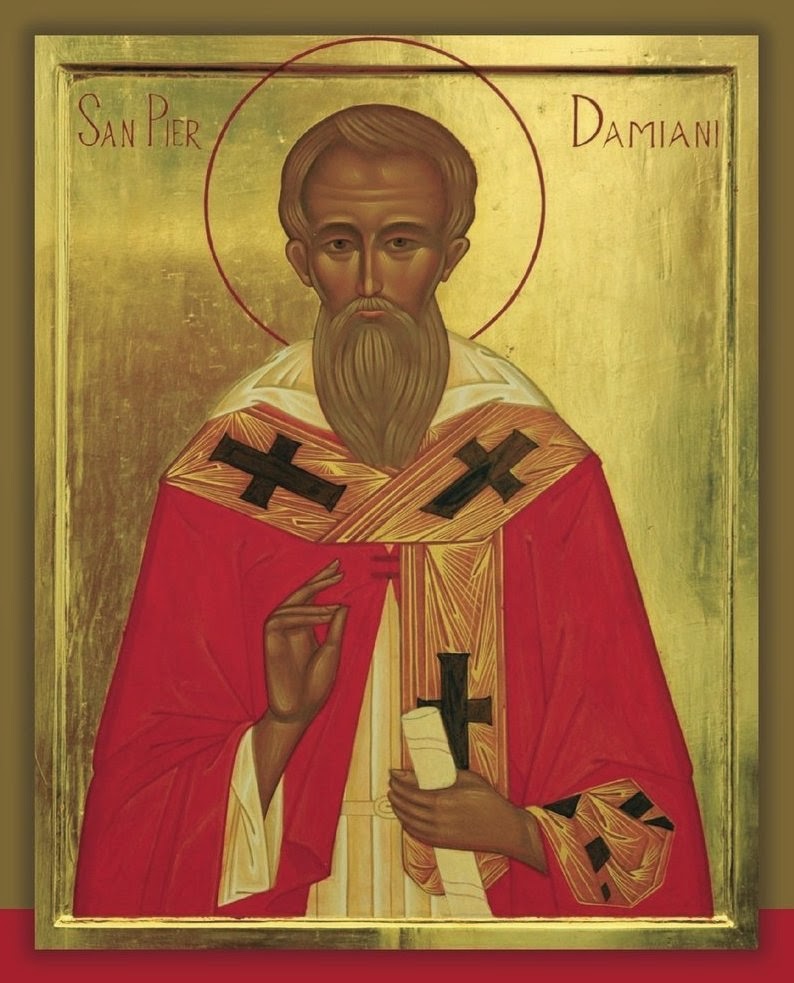St Peter Damian was born to a poor family in Ravenna, Italy in 1007. He lost his parents early in his childhood. An older brother took him into his household but treated him poorly. Seeing Peter’s remarkable piety and intellectual gifts, another of his brothers, who was Archpriest at Ravenna, felt deeply for him and helped provide for his education, sending him to school at Faenza and then at Parma, eventually leading to Peter becoming a professor of rhetoric at Ravenna. In gratitude for the mercy shown him, he took his brother’s name, Damian, as his last name.
St Peter is known to have taken to different forms of asceticism: wearing a hair shirt, fasting and spending hours in prayer, drawing strength from the recitation of Psalms. He always shared a meal with the less privileged at the table, giving away so much of his money in alms that he was left with very little for himself. It was his way of meeting Christ in people. After a while, he started pondering leaving the worldly way of living, embracing a monastic life.
Just then, two religious of St Benedict, belonging to Fonte Avellana of the Reform of St Romuald, happened to stop by at the house where he lived, learning from them about the Order and the hermits’ way of life. This helped him gain clarity of vision and he joined their hermitage community in 1035, leaving behind his teaching career of five years. The hermits lived in pairs in separate cells, living on bread and water, praying 150 Psalms daily. St Peter was so eager to pray that he slept very little and started suffering from insomnia. He was advised by his superior to be more prudent in taking care of his health. When he was not praying, he used to study the Bible and became a skilled preacher. He was sought after by other monasteries to help monks grow in holiness. In 1043 he was chosen as the prior of the Benedictine community. During this time, he expanded the monastery and extensively worked on improving the library. Five other hermitages were established under his leadership.
During Peter’s lifetime severe corruption troubled the Church, including the sale of religious offices and immorality among many of the clergy. As the Prior, and through his writings and preaching, he called on members of the hierarchy and other religious orders, to live out their commitment to Christ in earnest and strive for holiness. He was kind in his teaching, always asking for reformation of flesh and spirit from the clergy. However, he did not shy away from reprimanding wandering monks and clergy.
In November 1057, he was consecrated as Bishop of Ostia by Pope Stephen IX. He also joined the College of Cardinals and wrote a letter encouraging members to set an example for the whole Church. Wishing to restore discipline among religious and priests, he warned them against needless travel and too much comfortable living. He was a gifted writer who wrote some 170 letters as well as 53 sermons and seven biographies (including one of St Romuald). He made use of examples and anecdotes in his writing, making it easier for the ordinary reader to understand.
With Pope Stephen’s death in 1058, Nicholas II was elected as his successor. St Peter Damian supported Pope Nicholas against a rival claimant to the papacy and was the Pope’s representative when a crisis broke out over canonical and moral issues. He had to confront rioters who rejected papal authority.
St Peter wished to retire from all these controversies. With Pope Nicholas’ death in 1061, there was another papal succession crisis which St Peter helped to resolve in favour of Alexander II. The Pope kept St Peter occupied with a series of negotiations for the next six years.
In 1067, Pope Alexander II consented to his resignation request after which he returned to the monastery at Fonte Avellana. Even in retirement, he was called to serve as a papal legate for two years. In 1071, he made a pilgrimage to Monte Cassino, the first abbey of the Benedictine order.
On his return journey to Ravenna he contracted a fever. On the eighth day of illness, 22nd February 1072, he succumbed to it in the presence of his fellow monks who were saying the Divine Office. He was never formally canonized, he was celebrated as a saint after his death. He was declared a Doctor of the Church in 1828 by Pope Leo XII. He is the patron saint of Faenza, Italy.
His feast day is celebrated on 21st February.




